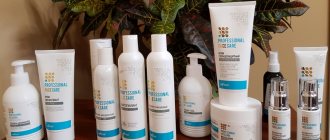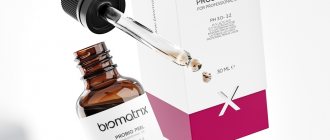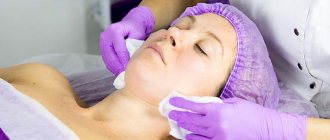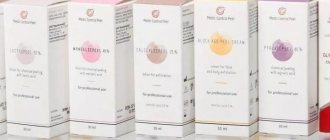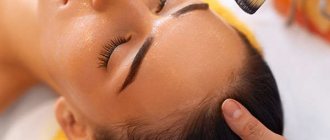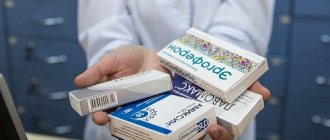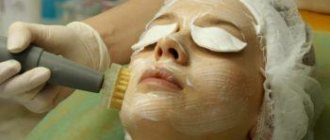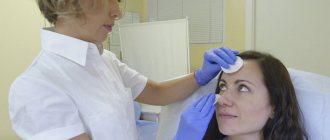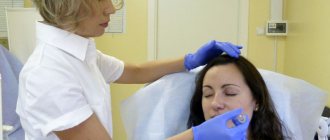Phenol is the simplest representative of the phenol class. Previously, phenol was obtained from coal tar, but now the cumene method is more often used. By oxidation with atmospheric oxygen, phenol and acetone are obtained from cumene. In terms of production volume, phenol ranks 33rd among all substances produced by the chemical industry and 17th among organic substances. It has a specific smell of gouache, since gouache contains phenol. Widely used in industry, agriculture, medicine and other industries.
Phenol is part of many antioxidants, preservatives, deodorants, antiseptics, and medicines (aspirin). Aspirin has the same detoxification pathway as phenol and can also cause methemoglobinemia. Therefore, when carrying out phenol peeling, it is imperative to carefully collect anamnesis from patients, specifying what medications they are taking. A solution of 1.4% phenol is used in medicine (orasept) as an analgesic and antiseptic. This property of phenol is very successfully used today by manufacturers in modern chemical peeling formulas. Phenol is added to the TCA peel formula to make the procedure more comfortable for patients. The concentration of phenol in this case is minimal and non-toxic, and the procedure protocol is no different from the protocol for the superficial-medial peeling of THC 15%, however, the procedure becomes more comfortable for the patient.
Traditionally, in aesthetic medicine, phenol is used as a deep peeling. It is important to understand that applying undiluted 88% phenol to the skin causes rapid and complete coagulation of epidermal proteins, as a result of which its further penetration is prevented.
Thus, pure phenol is classified as a medium-depth peel and, due to the availability of non-toxic mid-peel options such as TCA, phenol peels are used very rarely as mid-peel peels. However, TCA is dangerous for deep peeling procedures, since in a concentration of more than 50% it often causes scarring. Phenol, on the contrary, in comparison with other components, is the safest. And the main task of specialists was to find and use substances in combination with phenol that promote its deeper penetration.
The indications for this procedure are quite specific, namely type 3-4 aging according to Glogau, scars. Deep peeling damages the papillary dermis, the outer part of the reticular dermis and can affect the middle reticular dermis depending on the concentration. A narrow circle of patients agree to this procedure due to the difficult rehabilitation period. After deep phenol peeling, restoration of damaged epithelium occurs within three weeks and is usually accompanied by significant swelling. That is why, often, when a patient has indications for both a circular facelift and deep peeling, the doctor can combine these two procedures into one, provided that the treatment zones do not overlap each other, so that the rehabilitation periods after each of these procedures proceed parallel. If the zones overlap, then plastic surgery is performed first, and then, no earlier than 6 months later, deep phenol peeling.
However, there are cases when phenol can be prescribed to patients for health reasons, for example lentigo maligna. In this case, phenol can become the drug and method of choice for the doctor, as it shows better long-term results compared to other treatment methods, and compared to surgical excision, it is much simpler to perform and aesthetically pleasing.
An important advantage of phenol peeling is that, unlike medium, and especially superficial peeling, the rejuvenating effect of this procedure lasts up to 10 years.
Despite good results in the treatment of most cosmetic imperfections and a long-lasting effect, deep phenol peeling is used infrequently, primarily because this method can lead to serious post-peel complications, such as delayed healing and scars , infection and pigmentation disorders. When performing a classic phenol peeling procedure, monitoring using an electrocardiogram and biochemical blood tests is required. These circumstances determine the need to carry out the procedure in a hospital setting. The success of the procedure depends on many factors, such as a correctly collected anamnesis and identification of diseases or dysfunctions of internal organs (heart, kidney, liver failure), taking medications (aspirin-containing drugs), patient preparation, physico-chemical properties of phenol peeling, correct selection of the required formula and concentration.
The Baker-Gordon formula became the standard phenol peel for many years. And all further research was aimed at finding ways to prevent the undesirable effects of phenol toxicity and achieve more precise control of the depth of penetration of the peeling. Contraindications to this procedure are: pregnancy, cancer of any etiology, chronic skin diseases, acne, eczema, psoriasis.
Complications and side effects
Some of the possible side effects are associated with improper preparation for the procedure or insufficient examination of the body. Others depend on compliance with the order of its implementation:
- Toxic damage to internal organs, problems with the heart, liver and kidneys;
- Risk of serious burns;
- Atrophic changes;
- Increased sensitivity of the epidermis;
- The appearance of depigmented areas of the skin, sharp boundaries between treated and untreated areas, hyperpigmentation (with impaired liver and kidney function);
- Keloid scars, erythema, enlarged pores, exacerbation of skin diseases;
- Infectious and fungal diseases;
- Allergies;
- Persistent swelling.
Considering the large list of possible complications, many cosmetologists recommend using phenol exfoliation only as a last resort if it is impossible to get rid of defects in other ways.
Text author: Olga Lapina
Share your feedback if you could decide to do this.
Contraindications
It is not recommended to resort to peeling if:
- the patient's age is less than 18 years;
- at the time of testing, the patient is pregnant or breastfeeding;
- there are burns on the skin;
- there are diseases associated with the performance of internal organs;
- there is hypersensitivity to any of the components of the solution;
- at the time of treatment the woman is menstruating;
- a mental disorder was discovered;
- infectious diseases have been identified.
This procedure has many contraindications.
Note! Also, peeling should not be performed on older people over 60 years of age.
Phenol peeling: preparation and features
The degree of toxic effects is controlled not only by the concentration of the carbolic component, but also by additions to the drug formula. The percentage of oil in the composition regulates absorption, allowing chemical components to penetrate into the skin gradually. The load on internal organs is reduced due to the frequency of micro-dosed release of toxins into the circulatory system.
Preparation for the procedure follows the examination phase. Depending on the chosen formula, the pre-peel period lasts from 30 days to 7 weeks. The skin is prepared with care compositions with a low proportion of acids, which reduce the risks of uneven damage to the layers and increased post-operative pigmentation.
A comprehensive intake of antioxidants with antiherpes drugs is important for the result, as is the elimination of mechanical effects on the area of application of the composition for 10 days. Phenol peeling is a seasonal (spring-autumn) procedure; tanning is contraindicated 3 months before surgery.
Execution technology
Manipulations with the phenol-based composition are carried out in clean medical rooms with mandatory forced ventilation. The procedure takes from 30 minutes to two hours, depending on the scope of work:
- Areas of influence of the composition of deep and medium penetration are marked: around the eyes, perioral area, accumulations of scars, wrinkles.
- The anesthesiologist performs a complex of pain-relieving procedures, intravenous anesthesia for painful deep interventions, and local anesthesia for mid- and mid-superficial phenol peeling.
- This is followed by pre-treatment with an antiseptic followed by drying.
- Apply the composition evenly and in compliance with time intervals between treatment areas.
- Applying a gel layer based on lactic acid with phenol in a small dose.
- After the second layer has dried, a silicone-based gel barrier mask is placed on top. Its purpose is to protect the composition from oxidative processes in air, supporting uniform absorption of phenolic components for the next 48 hours.
On the first day of the postoperative period, it is important to prevent moisture from entering the treated areas of the face; water acts as a powerful catalyst and can provoke an intensification of the chemical reaction with negative consequences. For the sake of beauty, you will have to refrain from brushing your teeth and drink only through a straw
Preparation before the procedure
A week before phenol peeling, you should stop using medications that contain aspirin - this substance in combination with phenol increases the risk of bleeding. If herpes appears frequently, you should first take a course of Acyclovir.
Expert opinion
Ekaterina Dudikova
Dermatologist, cosmetologist
Phenol in the human body is destroyed by the liver, its remains are excreted by the kidneys. Therefore, before phenol exfoliation, a preliminary check of the functioning of the cardiovascular system, kidneys and gastrointestinal tract is carried out.
A few weeks before cleaning, you should stop shaving, hair removal and mechanical peeling.
Advantages and disadvantages of phenol peeling
Compared to other types of peeling, phenol peeling has both advantages and disadvantages.
Of course, the effect of its use is more pronounced and lasts for a long time, since the composition affects the deepest layers of the skin.
After just one procedure, the result lasts up to ten years. The application of the composition takes place under the careful supervision of a specialist. At the same time, the structure of the skin changes for the better, even serious age-related changes in the skin - deep wrinkles and age spots - disappear. The skin tone increases, and, consequently, its elasticity and firmness.
The skin acquires an attractive appearance and begins to shine with beauty and health.
However, despite the undeniable advantages, phenol peeling has many disadvantages and the most important of them is a huge number of contraindications for the procedure.
Before carrying out such peeling, a thorough examination is required. The procedure itself is quite painful and requires a long rehabilitation period. Complications are also possible.
Performing phenol peeling - stages of the procedure
Before performing phenol peeling, special preparation is required. It consists of a thorough examination of the body and treatment of the skin with special solutions for one and a half months. This eliminates the use of drugs that can lead to uneven penetration of the product inside. Three months before the procedure, you should not sunbathe in the sun or in a solarium.
Deep peeling is carried out only locally – where it is needed. In other areas, a medium or superficial phenol peel is performed.
The skin is degreased before the procedure. Then anesthesia is performed and a phenolic drug is applied. Carbolic acid is neutralized with a special mask, after which sunscreen is applied to the skin.
Rehabilitation period
Immediately after the procedure, patients feel an unpleasant burning and tingling sensation in the skin. If pain occurs, painkillers are prescribed.
The skin after phenol peeling has a bright red color. Her recovery begins after a couple of weeks.
At first, it is unacceptable to get water on your skin. It is recommended to treat it with panthenol or some other anti-burn agent on the recommendation of a doctor.
You can’t be in the sun or tan in a solarium for a year. You can go outside only after applying sunscreen with a high level of protection.
Preparation process
The sequence of actions in this case is as follows:
- Complete medical examination of some internal organs. These include the heart, liver and kidneys.
- Treatment of leather with special means. The course of treatment should last for a week.
- Taking antioxidants for two to three weeks.
- Stop taking retinoids six months before the procedure.
- Avoid epilation, shaving or mechanical cleaning two weeks before peeling.
- Refusal to perform laser operations six months before the procedure.
- Identification of possible allergic reactions and subsequent notification of them to a cosmetologist or dermatologist.
- Taking medications that help strengthen the body's immunity.
It is important to prepare thoroughly before the procedure
Note! It is also recommended to avoid walking in the sun and artificial tanning.
Peeling
Doctors strictly follow the instructions for treating the skin with phenolic and auxiliary substances to minimize the risk of serious damage. The manipulation is carried out only in a hospital; it is strictly prohibited to do it at home; it can be dangerous to health and life.
The whole process consists of the following stages:
- Local anesthesia is administered or general anesthesia is given.
- The face is cleaned with a hard sponge dipped in soapy water.
- For degreasing, a 70% alcohol solution is applied.
- Carbolic acid is applied to problem areas using a cotton swab. Then a silicone mask, and after that an oil gel. Excipients can increase the effectiveness of the procedure and reduce the aggressive effect of phenol.
- And at the very end, the face is covered with a “Jeleo” wax mask; it guarantees an even distribution of the acidic product and neutralizes it.
- The mask along with the keratinized layer of skin is removed after 48 hours. Wounded tissues are treated with antiseptic drugs and then moisturized. The last step is to apply a sunscreen with the highest SPF level.
Mimic activity is limited as much as possible. You need to drink and eat through a straw so that liquid does not get on your face, as it reacts with phenol and can cause a burn.
How to care for your skin after procedures
The following factors must be considered in the process of proper rehabilitation after such a serious exposure:
- Immediately after the procedure, do not come into contact with water for 3-5 days; contact with the skin can cause a burn. It is not advisable to even brush your teeth, and only eat liquid food with a straw.
- Analgesics will help with unpleasant pain.
- During the period of intensive crust formation, it is recommended to use panthenol, which will speed up the healing process and remove swelling.
- It is strictly forbidden to peel off the scabs yourself - this can lead to scars on the face.
- The recovery period itself lasts 6-8 months, during which it is necessary to avoid tanning, and when going outside, use a cream with a high sun protection factor (30-50 SPF).
Interesting: taking vitamins A and C, as well as antioxidants, accelerates the process of regeneration of the epidermis after peeling.
Features of the procedure
The mechanism of action of deep chemical peeling is quite simple: when applied to the skin, phenol helps to destroy the bonds between corneocytes, which causes severe peeling of the skin, activates the synthesis of glycosaminoglycans and skin proteins, resulting in smoothing wrinkles and improving the overall condition of the skin. Carbolic acid penetrates right up to the papillary layer of the dermis, provokes the development of a severe burn and thereby contributes to the complete reconstruction of the dermis and epidermis.
The danger of peeling is that phenol very quickly penetrates the skin barrier, enters the body (its absorption occurs in the intestines) and has a toxic effect on brain tissue. It causes dysfunction of the central nervous system, convulsions and irritation of the mucous membranes. From the intestine, phenolic acid enters the liver, where it is neutralized, and it is removed from the body by the kidneys. Experts recommend doing superficial and medium chemical peeling of the face, and using deep chemical peeling as rarely as possible, since rapid treatment of the skin with phenol leads to the fact that a lot of toxin enters the body and the internal organs cannot cope with its neutralization.
Indications:
- wrinkles;
- age-related changes in the skin;
- hyperpigmentation;
- senile hyperkeratosis;
- post-acne;
- hypertrophic scars.
Properties of phenol
Phenol is called carbolic acid. The substance is volatile and has a strong pungent odor. If it gets on the skin, it causes an immediate reaction. As a result, the active production of glycosaminoglycans and proteins begins, restoring the epithelium and increasing the elasticity of the skin.
Note! Thus, after using phenol, facial skin becomes more elastic, smooth and fresh.
After using phenol, the skin becomes smoother
Despite its beneficial properties, phenol is also considered a toxic substance. When it comes into contact with the skin, it overcomes almost all its layers, penetrating into the body. Over time, phenol components begin to negatively affect brain tissue and are also absorbed into the intestines. As a result, a person may experience seizures, respiratory problems, and bruises. Also one of the side effects is loss of coordination in space. However, the substance does not manifest itself as a carcinogen.
But it is important to note that such problems, as a rule, do not arise, since the procedure does not use pure phenol, but a solution with it, which also contains glycerin, oil and other components.
Note! Despite this, deep phenol peeling is recommended to be done as rarely as possible.
Phenol can cause various side effects, but if used correctly they are unlikely to occur.
Initially, the substance, entering the body, reaches the intestines, where it begins to disintegrate into two components. They are subsequently absorbed by the liver, in which another modification of the substances occurs. As a result, they become harmless and combine with water.
Phenol is excreted from the body through the work of the kidneys. With the help of such disposal, the safety of internal organs from the effects of carbolic acid is ensured. However, the liver and kidneys are not able to cope with large amounts of phenol and remove it in a short time. Therefore, the principle works here: the less, the better.
Thus, given that the organs of the gastrointestinal tract are responsible for the elimination of phenol, it is recommended to undergo examination of the kidneys and liver both before and after the procedure. In addition, it is worth undergoing an additional examination of the heart, since acid can cause problems in the functioning of such an important organ.
Note! To avoid this, the procedure itself is accompanied by cardiac monitoring, which monitors the patient’s heart rate.
Before the procedure, you must undergo an examination
Biochemists Tretman and Helen-Bay proved the existence of a relationship between the amount of carbolic acid administered and its effect on the condition of the human body. Thus, when using this substance, it is worth considering factors such as:
- concentration of phenol in the preparation;
- the area of skin that needs to be treated;
- speed of application of the product to the skin.
Based on the results of the studies, it was found that a small amount of carbolic acid is not capable of causing a strong toxic effect on internal organs and brain function. In addition, if you apply the substance slowly, the liver will have time to process the acid into harmless components and prepare for their elimination. If you treat your facial skin quickly, you can cause a negative reaction from the body to an increase in the amount of substance inside.
A small amount of phenol is not capable of harming the body, especially if it is applied to the skin slowly
Additionally, it is worth considering that the effects of acid can be enhanced by taking certain medications. For example, the liver in the same way neutralizes aspirin and other medications of this kind that penetrate inside.
Note! When peeling and taking medications at the same time, the liver will experience a heavy load and is unlikely to cope with the task efficiently, which can lead to poisoning.
Care for a renewed face
The layers of the epidermis formed as a result of intensive regeneration are very vulnerable to external factors and require specific protection. First, don't disrupt your skin's natural exfoliation process by scrubbing it with your hands. Secondly, always remember to protect your face from ultraviolet radiation from the sun: after phenol peeling, you will have to protect your skin from sunlight for the rest of your life. When planning to go outside, be sure to apply a protective cream (SPF30). As for the use of moisturizing creams, they can be used just a few days after the peeling procedure.
After peeling with phenol, facial skin requires constant care
Cosmetic companies produce special peeling products with different phenol contents: soaps, scrubs and creams. Naturally, the amount of the main chemical reagent in them is minimal, so the procedure is painless and not so effective. So traditional phenol peeling remains the most effective, albeit radical way to give your facial skin a second youth.
Operating principle and effectiveness
Phenol facial peeling is designed to rejuvenate already mature skin and improve facial contour. Based on the name, it is clear that the active ingredient for the procedure is phenol (carbolic acid), which quickly dissolves in water and has an alkaline reaction.
Several years ago, surgeons’ hands were treated with this acid before surgery, until they noticed the harmful effects of phenol on the human body.
Now in cosmetology this substance is used in small concentrations as a resorption and cauterizing drug.
Carbolic acid has strong effects on the skin, namely:
- Strengthens the walls of blood vessels;
- Promotes the formation of new skin cells;
- Reduces inflammation;
- Renews the horny epidermal layer, due to the fact that it causes severe peeling.
- Disinfects the skin;
- Suppresses enzymes that break down hyaluronic acid, thereby rejuvenating the dermis.
Phenol peeling also has the following components:
- Distilled water - acts as a solvent for phenol;
- Glycerin – restores the water balance of the epidermis;
- Propylene glycol – promotes the destruction of sulfide bonds;
- Essential oils help speed up the healing of the dermis.
Here's what you need to know about this type of peeling:
- The effect is immediately visible and does not require cleaning several times.
- It is easy to control the step-by-step application of the solution to the skin;
- A worthy alternative to plastic surgery, also taking into account the fact that after surgery, cells are not renewed as well.
Significant “disadvantages” are:
- Unpleasant painful sensations during the session;
- Long preparation and a short period of skin recovery;
- Mandatory anesthesia;
- The risk of negative effects of the components of the cleaning mixture on the functioning of human internal organs.
Important: there is a danger of scars, hyperpigmentation and skin infection if the technology of applying the phenol mixture is incorrect or if the face is not properly cared for after the procedure.
Indications, contraindications
This procedure differs from other chemical peels in that it is essentially a last resort, that is, it is used in cases where the client’s age is no longer suitable for more gentle procedures (over 40 years old) or there are contraindications for other types of deep effects, for example, laser resurfacing.
Thus, serious age-related changes that cannot be eliminated in any other way can be considered indications for phenol peeling, namely:
- pronounced wrinkles;
- strong pigmentation;
- sagging skin;
- the presence of obvious scars, including post-operative scars;
- other defects that spoil the appearance of the skin.
Once in the body, carbolic acid is excreted through the kidneys and liver, poisoning them. But in small doses, these organs are able to neutralize the negative effects, but this will only happen when they are fully operational. That is why before carrying out phenol peeling it is necessary to undergo a complete examination of the body.
The reason why phenol peels, despite being such a risky and complex procedure, still remain popular today is because of the amazing results. Very rarely, women are dissatisfied with the peeling performed. In other cases, a pronounced lifting effect, getting rid of pigmentation and a network of wrinkles are especially noted.
This determines the presence of an extensive list of contraindications, including:
You can also read: Types of peelings
- various chronic diseases of the liver and kidneys;
- problems related to the nervous system;
- malfunction of the thyroid gland;
- age up to 18 years (in practice, as already mentioned, such a procedure is carried out only in adulthood, the number of exceptions is very small);
- a large number of moles on the face;
- diabetes;
- pregnancy and lactation;
- oncological diseases;
- individual intolerance to peeling components and much more.
In this case, a consultation with a doctor is mandatory, since only a complete picture of your health condition will help you draw a conclusion about the admissibility of peeling with carbolic acid.
At the same time, one should also take into account the fact that the time period during which such peeling can be done has not only a lower limit (35–40 years), but also an upper limit (60–65 years), since the ability of the liver to remove harmful substances from the body.
The essence of the procedure
The essence of the procedure is to improve the condition of facial skin. However, in order to achieve this, you should first of all undergo preparation for peeling. To do this, the patient is prescribed a course of medications aimed at avoiding herpetic reactions in the body. This helps strengthen a person's immunity.
The main procedure is carried out in a hospital setting (this is especially necessary for deep peeling). The timing is different for everyone. A session can last from half an hour to two hours - it depends on the condition of the skin and the age of the patient.
This peeling is carried out in stationary conditions.
The algorithm is a sequence of the following actions:
- The patient is given local or general anesthesia.
- A cosmetologist or dermatologist wipes the face with a sponge on which a degreasing agent is applied.
- Additionally, the skin is treated with alcohol.
- A basic solution consisting of two layers is applied. The first layer is phenol itself. The second is a thin silicone film. Finally, the skin is treated with an additional layer of oily gel.
- Peeling is neutralized using a film mask.
- Sunscreen is applied to the face, as the epidermis becomes sensitive to sunlight.
The procedure is carried out in several stages
Area of skin treated and speed of application
The concentration of the substance and its required quantity must be judged based on the area of the skin area in question that is supposed to be treated.
Today, most specialists adhere to superficial phenol peeling. Deep peeling is allowed only in the most extreme cases, when skin problems cannot be solved by superficial ones. In this case, it is worth considering the concentration of the solution used.
Note! If 2% concentration of phenol gets into the skin, the procedure can be fatal.
The most common procedure is superficial phenol peeling.
The rate of application should also be slow so that the liver has time to cope with the processing, and the kidneys have time to remove the toxin from the body. As for the area of skin being treated, it is recommended to use the acid in individual areas, avoiding applying the solution to the entire face.
Individual characteristics of the body
In addition to the main factors, it is also necessary to consider the individual characteristics of the body on the effects of phenol. Special attention should be paid to the functioning of the liver, kidneys and heart, since it is thanks to them that the safe use of the substance can be achieved.
This procedure is not suitable for everyone
Before the procedure, the patient is recommended to undergo a full examination to find out everything about the condition of his body. If the doctor ultimately approves phenol peeling, then you can make an appointment with a cosmetologist.
Impact
If we talk about the cosmetic properties of using carbolic acid, then during phenol peeling the substance has the following effects:
- Exfoliates dead skin cells. The process occurs as a result of the destruction of connections between the horny cells of the epidermis.
- Strengthens capillaries. Compaction of membranes leads to the fact that the walls of blood vessels become stronger, thereby improving their functioning.
Thanks to this procedure, the walls of blood vessels are strengthened - Rejuvenates. As a result of the use of acid, the active production of new cells begins, which leads to skin rejuvenation.
- Eliminates foci of inflammation. Inflammatory mediators are blocked by acid, allowing the condition of the epidermis to improve.
- Kills germs. Thus, various infectious diseases gradually disappear.
- Restores damaged areas. The regenerating effect is associated with the accelerated process of division of new cells.
Phenol peeling helps restore damaged skin areas
Note! To prevent phenol from having a toxic effect on the body, the peeling solution includes additional components, which have already been discussed above. All of them lead to a slowdown in the absorption of the active substance by the skin, allowing the internal organs to cope with the breakdown of phenol and its excretion.
Peeling review
Valentina:
“I started thinking about phenol peeling when deep wrinkles and signs of skin aging appeared. Before this, homemade peelings and cosmetics were available, but the moment came when it was necessary to choose. Since plastic surgery was not justified for me, I chose peeling. All my friends have already undergone this procedure and recommended a specialist who does a good job.
After the procedure, I came to my senses for several days. Swelling and pain appeared, but everyone insisted that this was temporary and a normal reaction to the procedure. She took medications to relieve pain.
And over time, after about a week, the skin began to return to normal. All the effects of the peeling went away after a few weeks, and the mask was completely removed, the crust fell off, and after a while the redness went away. And when I saw the result, I realized that all the torment was worth the effect. Pigment spots and wrinkles disappeared, the skin became young and soft. This is exactly the effect I expected.”
FAQ
Is it possible to carry out phenol peeling at home?
Doctors prohibit carrying out such a procedure at home. Phenol peeling can only be performed by a qualified doctor or cosmetologist who can organize hospital conditions. In addition, all precautions must be observed throughout the procedure.
How long does the effect last and when is it shown?
The main advantage of this procedure is that the effect lasts quite a long time. Doctors usually recommend resorting to phenol peeling after 40 years, when deep wrinkles and other signs of active aging are already visible.
It is better to resort to this procedure after 40 years
Many photographs taken after peeling are repulsive. Is it worth resorting to such a procedure?
Photos after peeling show a crust formed, which will disappear over time. This is a completely normal phenomenon, which you can get rid of after two weeks. Therefore, do not be afraid of such results.
Is phenol peeling painful?
Yes, the procedure is painful. But during this procedure, doctors administer local anesthesia or use general anesthesia.
To ensure that the patient does not experience discomfort, local anesthesia is given.
How is peeling different from surgery?
If we talk about a surgical operation, then such an intervention drapes the facial tissues, moving them. As a result, the configuration of the skin changes, but its appearance does not change. Peeling, in turn, completely removes dead cells, which leads to a rejuvenating effect.
Is it possible to combine the procedure with others? And with which ones, if so?
Yes, if you take into account time periods. For example, you can resort to facial plastic surgery if several weeks have passed since the procedure.
You can also combine peeling with biorevitalization. The latter means the injection of preparations containing hyaluronic acid into the patient’s skin. As a result, the functioning of fibroblasts improves, and the duration of the peeling effect increases. True, biorevitalization will have to be done 3-4 weeks after the session.
Phenol peeling can be combined with some other procedures
Finally, peeling can be combined with Botox or Dysport, which are also used as injections.
Complications and side effects
Exfoliation with phenolic acid in case of non-compliance with the cosmetologist’s recommendations for preparing and caring for the skin after cleansing, or the cosmetologist’s violation of the procedure protocol, threatens the patient with unpleasant effects. Among them:
- Hyperpigmentation – may go away over time, depending on the type and structure of the skin;
- Deformation, sagging of the lower eyelid (ectopia);
- Residual marks from a chemical burn, particularly around the lips and eyes;
- Redness on the face that does not go away until 4 months;
- Increased herpes, manifestation of various infections;
- Problems with the heart and kidneys;
- There is a noticeable difference between areas that were exposed to acid and untouched ones.
The phenol peeling procedure will restore youth and elasticity of the skin without surgery. However, before you agree to perform it, weigh the pros and cons, get examined and get ready for a long period of rehabilitation, followed by many years of beautiful and perfectly smooth skin.
Rules for the procedure
When performing peeling using carbolic acid, you should follow the following rules:
- Throughout the procedure, the patient must be connected to a device that monitors the heart rhythm. In this way, the doctor has the opportunity to notice problems in the heartbeat in time and stop the procedure. It is worth noting in advance that this type of peeling is contraindicated for those who have problems with the heart and kidneys.
- Before starting peeling, the doctor should give the patient a drink that can cause a decrease in the concentration of phenol absorbed by the skin. Also, during the procedure, the patient is given additional glucose.
- To avoid pain, local anesthesia is required.
During the procedure, a machine is connected to the patient that allows you to monitor your heart rhythm.
The area of the treated areas should not exceed 25% of the face area. Between treatment of several zones take breaks of 15 minutes.
Deep phenol peeling: how the procedure works
Preparation for deep and medium phenol peeling.
You should begin preparing for phenol peeling 5-7 weeks in advance (having previously undergone a general examination), treating the skin with weak acid solutions in order to even out the skin color.
If you apply a phenol-containing composition to unprepared skin, there is a risk of hyperpigmentation due to damage to the skin to different depths. At this time, it is recommended to take antioxidants and drugs that reduce the permeability of vascular walls
. For six months, you should stop taking retinoids (externally and internally) so as not to provoke increased peeling (loosening) of the skin, which can lead to burns and hyperpigmentation. When preparing the skin for the procedure, it should not be subjected to mechanical cleaning, shaving or hair removal (about ten days in advance). After tanning, at least three months should pass, and after laser procedures and mid-cleaning, at least six.
Procedure for deep skin cleansing with compounds containing phenol
- Due to the pungent odor, phenol peeling is carried out in well-ventilated areas
equipped with hoods. The procedure, depending on the characteristics of the patient’s skin and the tasks facing the cosmetologist, lasts from 40 minutes to two hours. - The cosmetologist outlines the areas where deep phenolic peeling will be performed and applies the composition to areas where wrinkles, stretch marks, and scars accumulate. In other areas, medium peeling is done. Phenol peeling is not done on the arms, chest, neck
and other places where keloid scars are likely to appear. - Intravenous anesthesia is performed (if deep exfoliation is to be performed) or local anesthesia (2% lidocaine) is given in the case of medium or superficial peels.
- The skin is cleaned with a brush, thoroughly dried and degreased with alcohol.
- Apply the preparation containing phenol with uniform and smooth movements, trying to maintain a five-minute interval between treatments of individual zones
. - After the end of the exposure time, a special film mask and a neutralizing composition are applied to the skin. The film mask is removed on the second day after the procedure.
- At the end of the procedure, sunscreen is applied to the facial skin.
Skin care after phenol peeling. Immediately after treatment, patients feel a burning sensation in the treated areas. The sensation may be so painful that painkillers must be taken
On the first day, it is very important to avoid contact with the skin of water, which can enhance the penetration of phenol, which can lead to unnecessary burns. It is recommended to drink through a straw and not brush your teeth
On the second day after the procedure, the film mask with the destroyed skin particles adhering to it is removed. The skin at this moment is bright red - a “living wound”; it cannot be wetted. Next, a tightening surface crust is formed on the skin, which is cared for using cosmetics with panthenol. Gradually, scabs (crusts of dying tissue) form on the skin, which under no circumstances should be forcibly removed. If this is allowed, then areas of hyperpigmentation and scars may appear in the treated area.
After superficial phenol peeling, the skin recovers in an average of two weeks. After deep phenol peeling, the process of skin restoration is completed 7-12 months after the procedure, and painful redness lasts for 2 months. During the entire recovery period, you should not sunbathe. Typically, the doctor draws up a restorative care program, which includes cosmetics with panthenol, whitening compounds, moisturizers based on hyaluronic acid and sunscreen with SPF 50+. At the same time, internal use of vitamin complexes is recommended.
Rehabilitation
At the end of the procedure, the patient will experience a strong burning sensation and pain in the facial skin, so the doctor may prescribe painkillers, which are recommended to be taken for several days.
As for the rehabilitation period itself, during the first day it is necessary to avoid contact with water and exposure to sunlight. The fact is that after peeling, the face is an open wound, so any such contact with water or the sun can lead to complications.
During the first day, you should avoid contact with water.
On the second day, you can remove the film mask. Along with it, dead cells will be removed, cleansing the skin of the stratum corneum. At the same time, do not be afraid of the purple color of renewed skin. Over time, it will acquire a light shade and a healthy appearance. During this time, it is also recommended to avoid contact with water.
Already on the third day, a tightening crust will begin to form. You cannot rip it off, as you can leave scars on the healing skin. It is best to use Panthenol to remove the crust.
You can’t rip the crust off your face
Note! At the end of the second week, we can talk about complete restoration of the epidermis. After this, the person can go out again. However, the final result and improvement in skin condition will occur only a year after the procedure.
At this time, cosmetologists recommend:
- refuse to visit beaches and solariums;
- use whitening products to restore complexion;
- apply moisturizers and sunscreens;
- start taking antioxidants and vitamins.
The skin will recover in about two weeks
If you follow the recommendations, the rehabilitation period will be significantly reduced.
We will talk about phenol peeling.
In 1882, German dermatologist Paul Gerzon Unna conducted experiments with various substances, including phenol. And a little later, in 1903, another doctor, K. McKee, suggested using phenol to treat scars on the skin after acne.
He conducted studies that proved the effectiveness of this substance, after which other scientists picked up this idea and began working on creating an optimal drug based on phenol.
And already in 1961, D. Baker and K. Gordon first published a formula for deep peeling, which used phenol in high concentrations from 60% to 88%, which often caused complications.
But further study showed that increasing the percentage of phenol in the peeling composition only increases the toxic effect on the body and does not affect the result in any way. Then the idea arose of conducting a mid-peeling with phenol in safe concentrations.
Thus, preparations with a phenol content of 25% to 35% were developed, which are used in modern medical practice.
Is phenol toxicity dangerous?
Experts have determined the concentration of phenol, which is not dangerous to the body. The amount of active substance should not exceed 23 mg per 100 ml of blood. Thus, the toxic effects of this substance can only occur when the permissible concentration of acid in the bloodstream is exceeded.
A specific, non-hazardous concentration of phenol must be used
The concentration of phenol entering the blood is determined by the following factors:
- The amount of substance applied to the skin. But it is worth considering that the lower the concentration of the solution, the faster it penetrates into the layers of the epidermis.
- Speed of application. In this case, two speeds are taken into account. The first is how quickly phenol is absorbed through the skin. The second is determined based on how quickly its destruction occurs.
- The area of the skin being treated. The larger the area to which phenol is applied, the more actively it will penetrate the body and enter the blood.
It is better if the product is applied slowly
Thus, if we consider the case of applying a 2% acid solution to the entire face, the result can be sad.
Note! Such an amount of a substance can be fatal, since the blood will have too much acid and the liver will not have time to cope with its breakdown.
Advantages and disadvantages of the procedure
First, let's remember the basics of organic chemistry: phenol (carbolic acid) is a rather toxic substance. To reduce toxicity, a specially selected composition is used, in which the effect of carbolic acid is softened by various oils, glycerin, propylene glycol and distilled water. An obvious disadvantage of the method is that, regardless of the dose, phenol causes poisoning of the body. Therefore, it has the following restrictions:
- pregnancy, breastfeeding;
- heart, kidney, liver diseases;
- vitiligo;
- acute renal failure;
- oncological diseases;
- herpes;
- age 60 years and older;
- In addition, phenol peeling is not recommended for people with dark skin pigmentation.
The main advantage of phenol peeling is its amazing lifting effect.
After the fly in the ointment, let's move on to the ointment - more pleasant facts. Like any acid, phenol destroys skin proteins, causing cells to divide and rebuild the skin. But most importantly, collagen begins to be intensively produced. It is he who gives the face the desired elasticity and freshness. Against age-related skin changes, such a radical cosmetic procedure has no equal. In just six months you will look ten to fifteen years younger. Phenol peeling is often compared in its effect to a circular lift. After this treatment, the skin will remain fresh and healthy for many years.
Expert opinions
Experts agree that chemical peels have a beneficial effect on facial skin when done by professionals. A person should take into account his individual characteristics and consult a cosmetologist before phenol peeling procedures. It is important to prevent the occurrence of adverse reactions and complications, and this requires both the professionalism of the cosmetologist and the trust of the client. A cosmetologist must know about all predispositions and allergic reactions in order to prevent their manifestation. If everything is in order, then phenol peeling has a very effective effect on the regenerative capabilities of the skin, thereby causing a rejuvenation effect.
Other experts believe that frequent use of phenol peeling, like any other, can lead to depletion of the regenerative resources of epidermal cells and collagen synthesis. They believe that in this way the number of cell regeneration cycles genetically inherent in each person can be very quickly used up, which will lead to rapid aging in the future.
It is not for nothing that phenol peeling is very popular in anti-aging cosmetology. It really restores youth and healthy radiance to the skin, also eliminating cosmetic defects. It is important to know when to stop and not take risks if there are contraindications.
Tell us in the comments your opinion about phenol peeling if you have already used it. Bookmark this article if you found it useful and interesting. Share it with your friends on social networks.
Photos before and after phenol peeling
Such deep facial peeling is recommended to be performed only once in a lifetime, but it gives a fairly strong lifting effect, which cosmetologists compare with facial contouring, thread lifting or bio-reinforcement.
An important fact is that the amazing results from this cosmetic procedure last for quite a long time (up to 10 years).
Numerous photos of women’s faces after phenol peeling show wonderful, sometimes incredible results! The skin becomes noticeably younger, deep wrinkles are not so pronounced, facial wrinkles on the forehead are smoothed out, nasolabial folds disappear.
Most of the photographs after this peeling once again prove the high effectiveness of the procedure, which helps to prolong youth and preserve the beauty of women without painful and life-threatening surgical interventions.
Incredible! Find out who is the most beautiful woman on the planet in 2020!
L oading. . .
Let's sum it up
Phenol peeling is a procedure that is very different from “standard” similar methods of influence. It is recommended to eliminate pronounced skin defects: post-acne, burn marks, scars or cicatrices. Of course, phenol peeling will also help get rid of wrinkles. But do not forget about the features of this method, its contraindications and side effects, as well as the rules of preparation. Be sure to first consult with a therapist, dermatologist and cosmetologist.
Complications and side effects
Exfoliation with phenolic acid in case of non-compliance with the cosmetologist’s recommendations for preparing and caring for the skin after cleansing, or the cosmetologist’s violation of the procedure protocol, threatens the patient with unpleasant effects. Among them:
- Hyperpigmentation – may go away over time, depending on the type and structure of the skin;
- Deformation, sagging of the lower eyelid (ectopia);
- Residual marks from a chemical burn, particularly around the lips and eyes;
- Redness on the face that does not go away until 4 months;
- Increased herpes, manifestation of various infections;
- Problems with the heart and kidneys;
- There is a noticeable difference between areas that were exposed to acid and untouched ones.
The phenol peeling procedure will restore youth and elasticity of the skin without surgery. However, before you agree to perform it, weigh the pros and cons, get examined and get ready for a long period of rehabilitation, followed by many years of beautiful and perfectly smooth skin.
Many consider phenol peeling one of the most effective procedures for skin rejuvenation. Others argue that it causes more harm to the body than good due to the toxicity of the drug used.
Before agreeing to such peeling or categorically refusing it, it is worth studying the principle of the action of the main component - carbolic acid.
Phenol (or carbolic acid)
- a powerful antiseptic that is used in medicine in the form of a 5% solution. It is absorbed almost instantly into the skin and in high concentrations is very toxic: the acid affects the nervous system and can cause serious poisoning.
Due to its aggressiveness, the acid has a quick and serious effect. When applied to the skin it causes.
This leads to renewal of the upper layer of the dermis and also accelerates the process of collagen formation.
As a result, the epidermis becomes more toned and less susceptible to external negative factors.
Types of peeling
In cosmetology, acid is used in doses in different concentrations.
For superficial exfoliation, a 3% solution is used, for medium exfoliation - 25%, and for deep exfoliation - 35%.
It is better to carry out such peeling permanently, and not at home.
A specialist can accurately determine the required acid concentration.
The session is terminated if the slightest side effects occur.
Photos before and after
Advantages and disadvantages
On to the pros
phenol exfoliation include:
- Long-term effect;
- Noticeable result;
- One-time execution.
Cons
the phenol method has more. Among them:
- Long recovery period;
- Painful sensations;
- The need for pain relief;
- Toxicity of the drug, which puts a serious burden on the entire body;
- Large list of contraindications.
Indications and contraindications
Among the problems that phenol exfoliation combats:
- , including deep ones;
- Flabbiness and decreased elasticity of the skin;
- Photoaging and;
- Scarring;
- Keratosis;
You should refrain from performing phenol exfoliation if you have the following contraindications:
- Age restrictions (peeling is not carried out for people under 18 and over 60 years old);
- and lactation period;
- Herpes in the acute stage;
- Diseases of the cardiovascular system, thyroid gland, kidneys, liver, diabetes, oncology;
- Fungal and infectious diseases;
- Hypertrichosis, skin diseases;
- Injuries, any damage to the integrity of the epidermis in the treatment area;
- Fever;
- Period of menstruation;
- Mental disorders.
Phenol exfoliation is also not carried out if there is an individual intolerance to the components of the drug, if the epidermis is prone to scarring, after a strong tan.
Features of phenol removal from the body
Diseases of the internal organs are a contraindication to phenol exfoliation, since it is quite difficult for the body to remove carbolic acid.
After application to the skin, phenol also has an effect on the intestines: the substance is absorbed, and then processed by the liver and excreted from the body through the kidneys.
Phenol is broken down into harmless metabolites in the liver, but its dysfunction can disrupt this process and thereby slow down the elimination of the toxin.
That is why before phenol peeling it is necessary to undergo a full medical examination to exclude side effects.
Reviews
Marina, Ekaterinburg
“You want to look good at any age, and that’s why I decided to undergo a phenol peeling procedure. The cosmetologist sent me for a short examination, after which I was allowed to use this procedure. As for the effect, after the rehabilitation period, the condition of the skin noticeably improved: it became smoother, pigmentation disappeared.”
Olga, Orenburg
“My job forces me to be around people almost constantly, so I simply have to take care of my appearance. The face is no exception, and recently I decided to take the advice of a cosmetologist who suggested that I undergo a phenol peeling procedure. During the session, I was given a painkiller, but I still felt discomfort. However, it is clearly worth it, as over time my skin became smoother and wrinkles disappeared. In general, I’m happy with the result!”
Patients note that although such peeling has a rather aggressive effect on the skin, the effect is excellent.
Yaroslava, Orel
“Even when I was young, I had a problem with acne. Over time, of course, it went away, but the scars remained, and it tormented me greatly. A friend advised me to use a procedure called phenol peeling, and I decided to try it. Moreover, no medications have ever coped with this problem. When visiting a cosmetologist, I was recommended a gentle peeling, since I was still quite young. But even after this procedure, the skin condition became noticeably better and the scars finally disappeared. The rehabilitation period lasts, of course, quite a long time, but the result is simply excellent.”
Deep facial peeling procedure
The phenol cleaning process lasts about three hours.
Throughout the entire session, the doctor must monitor the patient’s condition, and if any pronounced reactions appear, for example, bright redness, then the procedure is stopped immediately.
After such a serious cleansing, you need to take pain relief for the first couple of days. These days you can’t wash your face, even brush your teeth, and getting water on your face is unacceptable. Within a week, maybe up to 10 days, a film will peel off from the skin of the face, the face will resemble the skin of a baby with redness. The final restoration of facial skin will last up to 6 months.
Phenol peeling is a fairly expensive procedure, and recovery after it is also not a cheap pleasure. But it's worth it, especially if you want to regain your youth.
Features of peeling
The key feature of this type of peeling is that it is only possible in a hospital setting. This procedure cannot be carried out at home, at least due to the lack of necessary equipment and solutions.
This procedure cannot be carried out at home.
Skin recovery will take two to three weeks, and during this time swelling is possible. A crust begins to form on the third day and peels off in the third week.
Note! Skin color can change within six months.
Indications for use
Phenol peelings are the most radical type of skin cleansing and rejuvenation, which does not require surgical intervention, but is performed by exposing the epidermis to a chemical composition.
To carry out the phenol procedure, it is important to have the following indications:
- Disadvantages of facial relief (deep expression and age wrinkles, stretch marks, scars after surgery);
- Rapid withering of the skin, loss of turgor and tone;
- Symptoms of photoaging of the skin;
- Hyperpigmentation on the face, residual marks after sunburn;
- Consequences of acne, demodicosis;
- A number of dermatological diseases (certain types of keratosis).
Phenol peeling is a confident step to restore the youth of your face. Rest assured, you will experience renewed skin that is soft and supple. The face becomes perfectly smooth and toned, just like 10 years ago. At the same time, the active synthesis of your own collagen and elastin is launched, so the result lasts for another ten years.
Indications
Phenol peeling is recommended for:
- age-related changes;
- formations of deep wrinkles or folds on the face;
- the appearance of large and noticeable pigment spots;
- presence of scars;
- the occurrence of photoaging;
- deterioration of skin condition (flabbiness, loss of elasticity, appearance of wrinkles);
- acne.
There are certain indications for this type of procedure
In any of the above cases, you can apply for this type of peeling.
What effect to expect
Carbolic peeling guarantees high results very quickly. It has a beneficial effect on the functioning of skin cells and stimulates internal processes, including collagen production. Reviews from patients confirm the wonderful transformation of the skin after phenol peeling.
After the peeling procedure, the following changes occur in the skin:
- The rate of cell regeneration accelerates;
- The elasticity and firmness of the fibers of the skin are restored;
- The cells begin to actively function;
- Pigment spots disappear;
- The skin tone is evened out, they look fresher and younger;
- The relief of the face is smoothed out, small and medium wrinkles, scars and post-acne completely disappear;
- The contours become clear and toned;
- A pronounced lifting effect is observed.
It is difficult, but realistic, to believe in such a wide range of effects of phenol. A high result and restored youth justifies the complexity of the procedure, its toxicity and danger.
Cost of the procedure
Let us give the approximate price of a phenol peeling procedure in different cities of Russia. It is worth noting that the cost, in addition to the substance itself, includes hospital stay, the use of anesthesia, and the work of a doctor.
| City | Cost of one procedure |
| Moscow | 15000 rub. |
| Saint Petersburg | 12000 rub. |
| Ekaterinburg | 13400 rub. |
| Nizhny Novgorod | 12600 rub. |
| Belgorod | 11700 rub. |
| Rostov-on-Don | 10600 rub. |
| Vladivostok | 12900 rub. |
PROTOCOL
Phenol facial peeling causes pain, so it is performed under anesthesia. If we are talking about deep cleaning, it is carried out under general anesthesia.
Cosmetologists recommend using this peeling to cleanse the most problematic areas first, rather than the entire face - this will help reduce the toxic effects of phenol.
- Immediately before the session, the skin is cleaned with a soap solution, and then disinfected with alcohol and treated with an anesthetic (usually lidocaine). In the case of deep peeling, anesthesia is administered intravenously.
- Then a peeling composition is applied to the face, and this process should be slow, with breaks between treating different areas of the skin.
- At the next stage, a film mask is applied to the face, which neutralizes the acid, and then a sunscreen.
We recommend: Peeling with GARRA RUFA fish: the truth about the exotic business
The duration of the procedure , as a rule, does not exceed 2 hours.
Pre-peeling preparation
- 6 months before phenol exfoliation, you should stop taking retinoids and laser peels.
- For 10-14 days, it is necessary to exclude mechanical cleaning and epilation of the treated area.
- for 2 weeks before peeling, and for a week - antiherpetic drugs, which are selected after consultation with a specialist.
In addition, you need to stop visiting the solarium for 3 months
It is recommended to use whitening cosmetics.
Price
The price of 1 session varies from 40€ to 350€.
It is worth considering that we are talking only about phenol exfoliation itself.
Additional costs will be required for medications to prepare for the session and recovery.
In the case of deep phenol peeling, you also need to pay for anesthesia and hospital stay.
